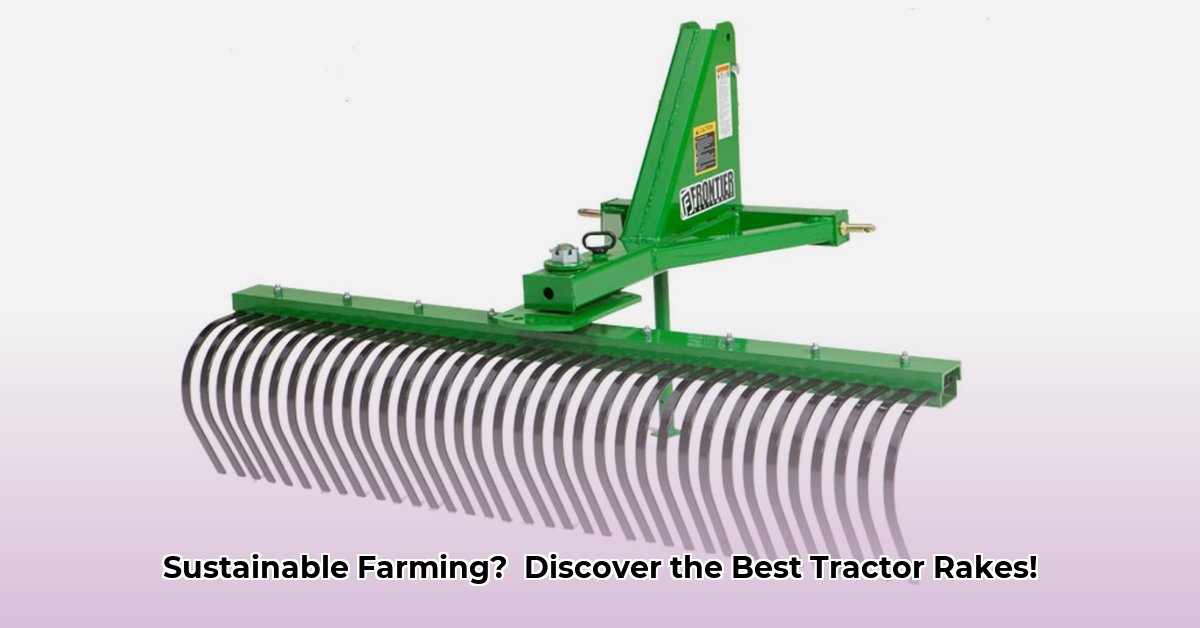
Tractor Landscape Rakes: Your Key to Sustainable Farming in 2024
Tractor landscape rakes are versatile tools revolutionizing sustainable agriculture. They go beyond simple land clearing; they improve efficiency and environmental stewardship. From preparing soil for planting to creating even mulch beds, these attachments offer significant benefits. This guide helps you navigate the selection process, ensuring you choose the right rake for your farm's needs. For more information on tractor implements, visit this helpful resource page.
What is a Tractor Landscape Rake?
A tractor landscape rake is an agricultural implement attached to a tractor, designed to level, smooth, and clear land. Think of it as a powerful, large-scale version of a garden rake. Various types exist, each with specific features optimized for different tasks. Key features include the tine (tooth) design, which impacts efficiency in gathering and moving materials; the presence of gauge wheels, which deliver precise depth control for leveling; and the overall construction material, which affects durability. These rakes are available in various sizes to match different tractor capacities and project scales.
[Insert image of a tractor landscape rake here]
Applications in Sustainable Agriculture
Landscape rakes play a vital role in sustainable farming practices by enhancing efficiency and minimizing environmental impact. Their applications include:
- Land Clearing: Efficiently removes rocks, debris, and unwanted vegetation, preparing land for planting. This reduces the need for extensive manual labor.
- Grading and Leveling: Creates even surfaces for planting and irrigation, improving water efficiency and crop health. Improved drainage also reduces water runoff and erosion.
- Soil Preparation: Breaks up compacted soil, improving aeration and water infiltration leading to healthier soil and better plant growth.
- Mulch Bed Creation: Evenly distributes mulch to retain soil moisture, suppress weeds, and reduce the need for herbicides.
- Erosion Control: Level surfaces minimize soil erosion, preserving topsoil and nutrient-rich soil.
Choosing the Right Landscape Rake: A Step-by-Step Guide
Selecting a landscape rake requires careful consideration of several key factors:
1. Size and Capacity: Match the rake's working width to your tractor's capabilities and the scale of your project. An oversized rake on a smaller tractor is inefficient, while an undersized rake will take significantly longer for larger projects.
2. Tooth Design: Different tooth designs are suited to various tasks. Aggressive, heavy-duty teeth are ideal for land clearing and removing tough debris, while finer teeth are better suited for creating smooth, even surfaces or preparing delicate seedbeds.
3. Gauge Wheels: These are essential for precise depth control, especially crucial for grading and leveling work, ensuring a consistent, even finish. The absence of gauge wheels can lead to uneven results.
4. Construction Material: High-quality steel construction, potentially using recycled steel, provides durability and longevity; this reduces the overall environmental impact by extending the rake's service life and minimizing replacement needs. Less durable materials may require more frequent replacement.
5. "Made in the USA" Considerations: Purchasing domestically-manufactured equipment offers several potential advantages, including reduced shipping times, easier access to parts and service, and support of local economies. However, this often comes at a higher initial cost. Weigh the long-term benefits against the initial investment.
Maintenance and Longevity
Regular maintenance significantly extends the lifespan of your landscape rake. This includes:
- Regular Inspections: Check teeth for wear and tear, promptly replacing or sharpening them as needed.
- Lubrication: Keep moving parts lubricated to prevent rust and ensure smooth operation, reducing friction and wear.
- Cleaning: Thoroughly clean the rake after each use to prevent the accumulation of mud and debris that can accelerate wear.
Proper maintenance translates to cost savings and reduces the environmental impact associated with frequent replacements.
Market Overview (Summarized)
Data on the agricultural landscape rake market remains limited, presenting opportunities for future research and analysis. This lack of comprehensive data highlights the need for further investigation into market size, growth trends, and consumer preferences. The following table summarizes potential challenges and solutions:
| Potential Problem | Potential Impact | Suggested Mitigation Strategy |
|---|---|---|
| Rake structural failure | Equipment downtime, potential injury | Invest in high-quality, durable rakes; thorough regular inspections are vital |
| Gauge wheel malfunction | Inaccurate grading, wasted time and resources | Regular lubrication and maintenance; consider having backup wheels. |
| Supply chain disruptions | Delays, increased costs | Research multiple suppliers; develop strong relationships with key suppliers. |
Conclusion: Investing in Sustainable Farming
A tractor landscape rake is a valuable investment for sustainable agricultural practices. By understanding the various types, features, and maintenance requirements, and carefully considering the factors outlined in this guide, farmers can select the optimal rake to improve efficiency, reduce environmental impact, and promote long-term sustainability. The initial investment provides substantial returns through improved land management and reduced operational costs.